Real men don’t eat quiche.
Which works fine for me, I’ll have their helping. Quiche is one of those things that when done well, sings like the Mormon Tabernacle Choir. The problem that real men have with quiche is that it’s been mostly presented to them in foil pie plates on block party buffet tables. You know the stuff I mean: curds of overcooked egg intermingled with pockets of cheddar cheese and pre-sliced ham. I’ll just have the Cheetoes.
Quiche is a “still” custard, one which as it happens is not baked in a water bath, since of course it has a crust. That crust happens to be one of the two critical components of a quiche, the other being the custard. Get both of them right and you can put just about anything in between, since fillings are almost irrelevant at that point…more like a garnish.
So then, let’s make one. The quiche I’m about to show you is a Thomas Keller-style job, which means its a fairly authentic French-style job. The main difference is that whereas French quiches tend to be dense and cheese-heavy, Thomas Keller’s are light and custardy, which is the way I like’em. Of course when I say “light” I don’t mean low-cal, since quiches are made of cream and cheese and butter crusts. What I’m really talking about is a silky, melt-in-the-mouth texture.
A righteous quiche feeds 10, takes an afternoon to make and needs a full night’s rest in the fridge. But I’ll tell you boys and girls it’s worth it. What you get in exchange for all that work and waiting is a real quiche. A man’s quiche. So let’s puff out our chests, spit and get on with it. The crust recipe goes like this:
10 ounces (2 cups) all-purpose flour
1 teaspoon kosher salt
8 ounces chilled butter cut into pieces
2-4 tablespoons water
First, put half the flour and the salt in the bowl of a mixer with a paddle attachment and turn it on low. Add the butter a few pieces at a time until the mixture looks like so:
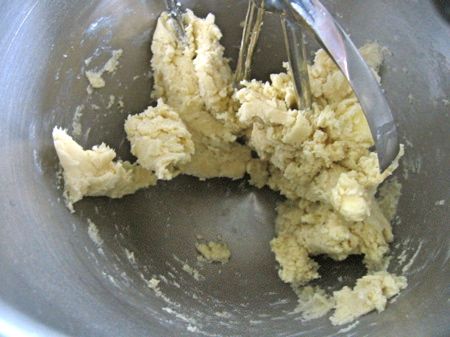
Next add the flour…
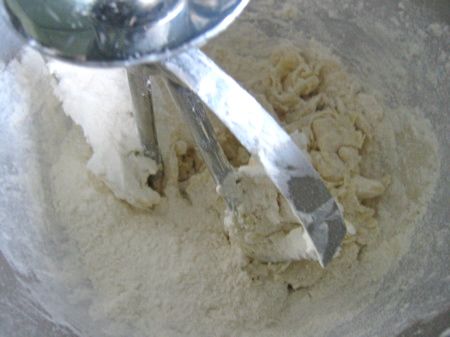
…and turn the mixer up to medium. When the flour has all been incorporated add two or three tablespoons of water and mix for 30 seconds or so until the dough looks like this:
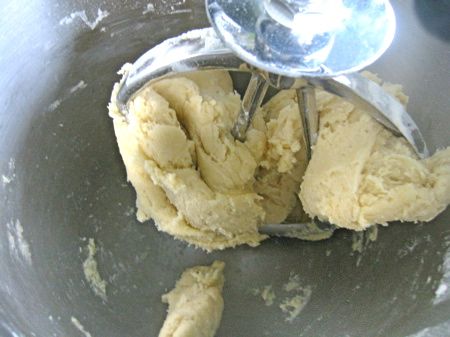
Pat the dough into a flat patty, wrap it in plastic wrap and and put it in the fridge for an hour. You’ll notice that this process differs from that of a standard pie crust in that the dough is worked a lot more. This is intentional since a flaky crust would tend to leak custard. This crust is smooth, but because it’s been worked it contains activated gluten and will tend to want to shrink in the oven. The process allows for that as you’ll soon see.
So then, while the crust is chilling, it’s time to fetch the form, which for all good quiches is a round, bottomless 9″ x 2″ stainless steel hoop (ring mold) like so:
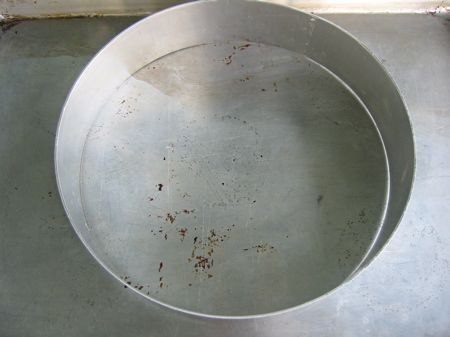
The cylindrical shape provides even heating as well as easy turn-out. All you need to accompany it is a flat sheet pan or cookie sheet to serve as a bottom.
So, assuming at least an hour has passed, preheat your oven to 375. Take your dough out of the fridge and apply it to a well floured board. Sprinkle the dough with more flour…
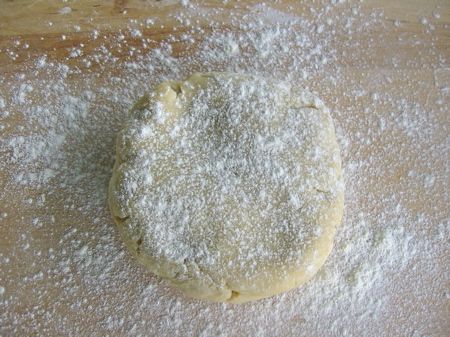
…and start to roll, dusting with flour and turning as needed to get it into a rough circle, about 16 inches across and a little less that 1/4 inch thick. You’ll notice that this dough is much easier to work with than pie dough. It’s all that gluten.

Once the dough has been rolled out pick it up and place it gently in the mold. You’ll notice there’s a good deal of excess most of the way around. Leave it there.
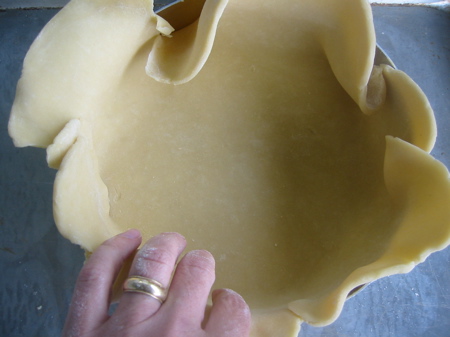
Gently but firmly press the dough down into the corners of the mold and press in the folds so the dough is of a fairly uniform thickness. About like so:

If the dough hangs over by much more than an inch, trim some off with scissors and put it in the fridge (just in case you need a patch). Put the sheet pan with the mold on it in the fridge for 30 minutes to an hour to let the dough rest and firm up a bit.
Now then, seizing the nearest piece of baking parchment, gently push it down into the mold, into the corners…
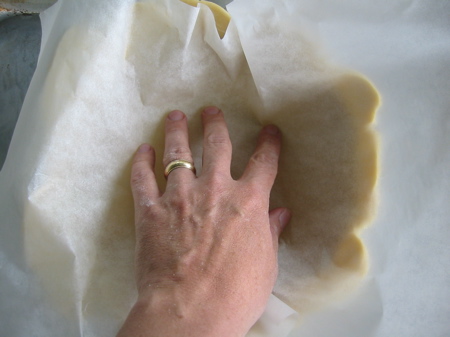
…and fill it up with dried beans (yes, I keep a big airtight container full of ’em in the closet just for occasions like this).
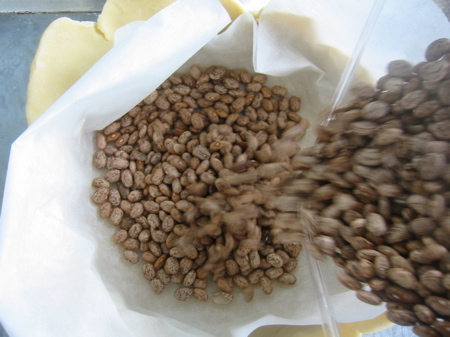
Put the whole works in the oven on a middle rack for 35 minutes or so, until the crust around the edges starts to brown lightly. At that point you want to remove the sheet pan from the oven, spoon the hot beans back into their storage container, get rid of the parchment, and put the pan back into the oven for 15 more minutes until the interior of the crust is golden. Like so:

You’ll notice there isn’t as much extra crust around the edges now. That’s because the gluten in the dough caused the whole thing to shrink up a little in the oven. However since there was excess all the way around, the shrinkage won’t cause the crust to shrink down below the mold’s rim. That’s the genius of this method.
Now it’s time to fill this bad boy and get it ready to bake (again). Turn the oven down to 325 and assemble the components of the custard, which are:
2 cups of heavy cream
2 cups of milk
6 large eggs
2 teaspoons kosher salt
1/4 teaspoon white pepper (fresh ground is ideal)
1/4 teaspoon fresh ground nutmeg
This is a fairly standard quiche custard, but what’s unique about Keller’s approach is that he whips it in a blender to give it that nice light texture I was telling you about. Begin by combining the milk and cream, scalding it (heat it until a kin forms), and letting it cool. Since a standard blender won’t hold the whole mix you’ll need to make it in two batches. Just split the recipe in half (2 cups of the scalded milk/cream mixture, 3 eggs…) and you’ll have no trouble. You want to blend each batch for 30 seconds until it’s nice and foamy.
Having completed the first batch of custard, it’s time to assemble. Begin by adding about half your filling. In this case my filling is composed of leeks (about four of them, big ones, whites only, sliced thin and blanched for 5 minutes in salted water) and comté cheese, about six ounces. Lay down half the blanched leeks…

…a little less than half the cheese…
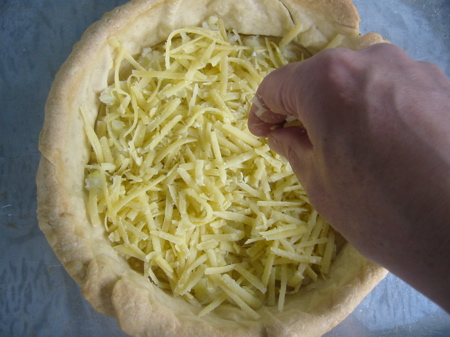
…and my first half batch of custard.

Next the other half of the leeks…

…almost all the rest of the cheese…
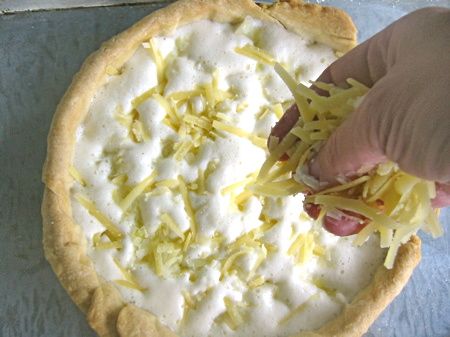
…the second half of my custard…

…and then the last few shreds of cheese for the top:
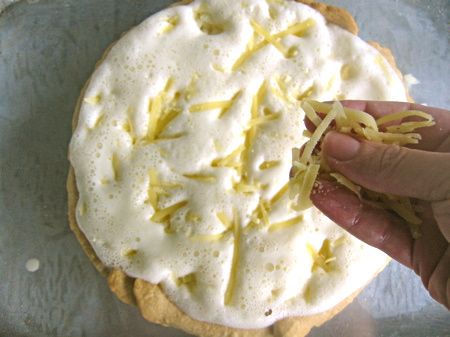
You’ll notice I’m getting a little bit of foam-over here, no biggie at all. Just don’t spill the thing on the way to the oven. In fact, you can wait until the quiche is in the oven to pour on the last of the custard and cheese (I normally do, but right now I’m taking pictures).
Bake your quiche for about an hour and 20 minutes (checking every ten minutes or so after an hour) until the quiche no longer sloshes when you jostle it, but wiggles like JELL-O. Until it looks about like so:

Let it cool on the pan to room temperature, then put the whole thing, uncovered, into the fridge at least overnight, but you can keep it for up to three days if you want to. When you’re ready to serve it, get a serrated knife and gently trim away all the excess crust…you won’t be needing it anymore.

Next, using an icing spatula, detach the quiche from the sheet pan (of course I could avoid this step by baking on parchment or a nonstick mat, but then I’m stupid).
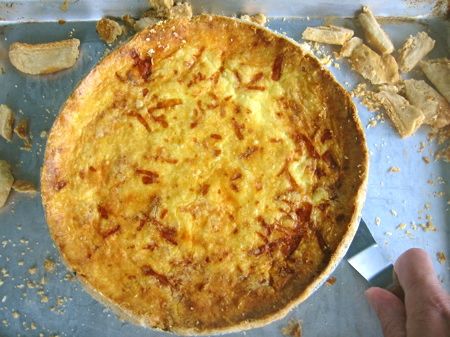
Now turn the whole thing on its side (don’t worry, the quiche is a solid mass by this time), and using that same icing spatula, gently detach the quiche from the ring mold.
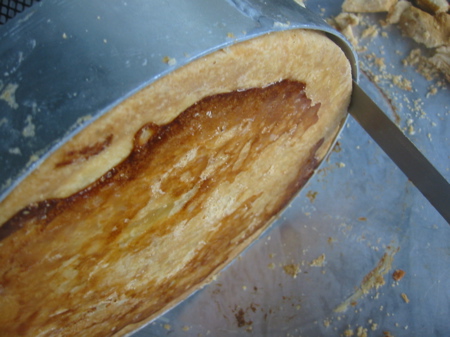
Pop it out of the mold…

…and voilà.
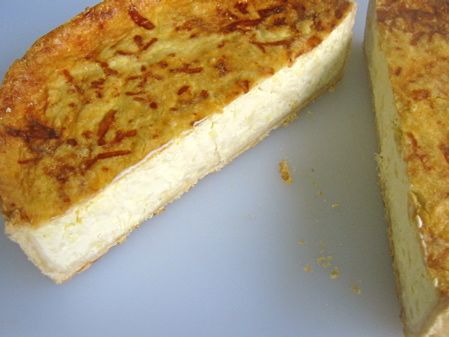
Man, that’s good quiche.
Amazing. Simply beautiful. After looking at this, how could anyone look at any other quiche. One question: how to you re-heat to serve, or do you not re-heat?
Can’t wait to do it. And easy.
again, just brilliant, thank you.
Hey Charles!
Thanks very much. I promise you’ll love this quiche. It takes time, but as you observed, it’s really not difficult. As far as re-heating, I’d just use a microwave to give it a little warmth. Quiche doesn’t need to be hot, or even warm really. On the Continent it’s mostly eaten cold. But I tend to agree that a stone cold quiche lacks a certain je-ne-sais-quoi. So give your slices a couple of short (5-10 second) zaps on high in the microwave, just to take the chill off if they’ve been in the fridge. That should do it. The thing you want to avoid is too much heat, which will make the custard curdle. Let me know how your quiche turns out!
Cheers,
– Joe
Joe,
Sir, thank you very much for the tip. And I absolutely will let you know how it turns out. In fact I will be doing up a meat pie – tourtierre – for Christmas and plan to utilize the pie crust in the spring pal a la savory pie you referred to. Can’t wait to try it. Will let you know on this as well.
And thx for the tip on the cream cheese frosting for my carrot cake. Another demand for Christmas.
Thanks again and, again, fab site. Have a Merry Christmas and best wishes for a happy, healthy and properous New Year
Very interesting. Are you writing from Quebec, then? I’m fascinated by that dish and hope to do it one of these days soon. Can you hook me up with a good recipe?
Keep in touch — and Merry Christmas!
– Joe
Do you know if you can freeze the quiche for longer storage?
Hi Catherine!
Unfortunately quiche, being a custard, doesn’t freeze very well. It’s usually quite watery when it’s thawed, which is caused by jagged ice crystals rupturing the gel. Sorry for the bad news!
– Joe
Darnit! Guess I’ll have to eat that second helping.
Rats.
I know this is an old post, but I have spent months trying to work out how to get straight sided pastry cases.
All the tins I see on sale have sloppy sides or fluting. I was beginning to get a little obsessed and frustrated.
So thank you very much for showing me the solution to this conundrum.
My pleasure Jess! You should be able to find rings in most restaurant supply stores.
Cheers,
– Joe
Thank you, Thank you for this glorious recipe. I have been making quiche for years and for the last several I haven’t been really happy with the results. I think it is because I fell out of the habit of making in blender. A few weeks ago I posted on Chow asking for a clue as to how to make a great quiche and was referred to your recipe. I must confess I was determined to make quiche for dinner that evening so I did take a few shortcuts but it turned out so wonderful I am now planning to make it following all of your directions. Thanks.
Pam
Pam! Thanks for the great comment. I appreciate it and am only too glad to keep doing what I do!
Great news and keep making quiches! 😉
– Joe